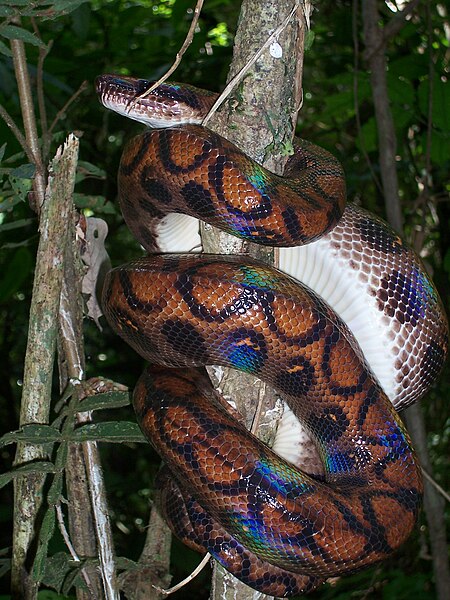 I usually recommend that aspiring snake breeders start off with live-bearing species, so as to avoid the necessity of incubating eggs. In the Family Boidae we find a wide range of possibilities, one of the most popular of which is the beautiful Rainbow Boa (Epicrates cenchria). Although not as widely kept as its much larger cousin, the Boa constrictor, the Rainbow Boa is far easier to manage in captivity, yet grows large enough (to nearly 7 feet in some cases) to satisfy those who prefer sizable snakes.
I usually recommend that aspiring snake breeders start off with live-bearing species, so as to avoid the necessity of incubating eggs. In the Family Boidae we find a wide range of possibilities, one of the most popular of which is the beautiful Rainbow Boa (Epicrates cenchria). Although not as widely kept as its much larger cousin, the Boa constrictor, the Rainbow Boa is far easier to manage in captivity, yet grows large enough (to nearly 7 feet in some cases) to satisfy those who prefer sizable snakes.
Range and Diversity
Eight subspecies of Rainbow Boa range throughout much of Central and South America (Panama to Northern Argentina).
Black rings on a rich red-orange background mark the most highly desirable of these, the Brazilian Rainbow Boa (E. c. cenchria). The somewhat duller but still attractive Columbian Rainbow Boa (E. c. maurus) is more commonly available. Both of these snakes, and the remaining subspecies, may be bred in a similar manner.
Selection of Breeding Stock
Although occupying a wide range of habitats, Rainbow Boas from all locales usually respond well to similar breeding techniques. Captive-bred animals are easier to work with than wild-caught individuals, as the “internal clocks” of wild snakes may conflict with local conditions – wild-caught animals will usually reproduce only during their normal breeding season, and after being exposed to a very close simulation of natural conditions (rainfall, temperature, etc.).
Potential breeders should be robust, at least 3 years of age and approximately 5 feet long, so that sexual maturity is assured. Small and/or young females often give birth to a high percentage of stillborns.
Stimulating Reproduction
Despite their tropical origins, Rainbow Boas selected for breeding should be subjected to a 6 week cooling-off period, at temperatures of 68-70 F. Over much of their natural habitat, such temperature dips are associated with rainy periods. Increased misting may, therefore, help spur reluctant breeders, but care must be taken that the snakes dry off completely, lest fungal skin infections take hold.
Snakes slated for cooling should be fasted for 2-3 weeks beforehand (undigested food in the gut of a cool snake will spoil and likely kill the animal). A water bowl should be available during their artificial “winter”.
At the end of the cool period, temperatures should gradually (over a 10 day period) be raised to 78-85 F, with a basking site of 92 F. Females give birth 6-8 months after copulation, and produce an average of 10 young per litter (the range is 1 to 25). Newborn Rainbow Boas are large enough – 14 to 24 inches – to take fuzzies or small mice as a first meal.
A Note Concerning Diet
I’ve found that Rainbow Boas often refuse favored foods after a time. Usually, a switch from mice to rats, or vice-versa, gets them started again.
Rainbow Boas usually relish chicks, and may take gerbils, hamsters and other rodents, but these should not be used unless a steady supply is available. Snakes that “fixate” on a difficult-to-obtain food can be trouble. I once worked with an anaconda that refused all food but muskrats, another which took only wild-caught Norway rats, and several that “demanded” ducks.
Further Reading
Information on the natural history of the Brazilian Rainbow Boa and other creatures that live in its habitat may be found in the newsletter of The Amazon Conservation Association.
A video of a nicely colored young Brazilian Rainbow Boa is posted here.
Peruvian Rainbow Boa image referenced from wikipedia and originally posted by Damien Farrell
 That Reptile Blog – Reptile, Amphibian and Exotic Pet Care and Information
That Reptile Blog – Reptile, Amphibian and Exotic Pet Care and Information


